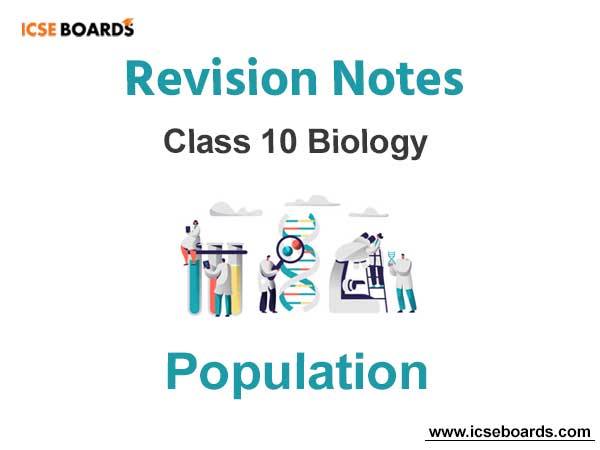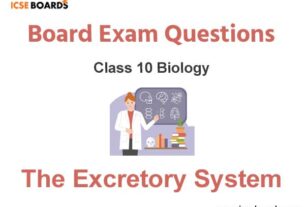Students should refer to Population ICSE Class 10 Biology notes provided below designed based on the latest syllabus and examination pattern issued by ICSE. These revision notes are really useful and will help you to learn all the important and difficult topics. These notes will also be very useful if you use them to revise just before your Biology Exams. Refer to more ICSE Class 10 Biology Notes for better preparation.
ICSE Class 10 Biology Population Revision Notes
Students can refer to the quick revision notes prepared for Chapter Population in Class 10 ICSE. These notes will be really helpful for the students giving the Biology exam in ICSE Class 10. Our teachers have prepared these concept notes based on the latest ICSE syllabus and ICSE books issued for the current academic year. Please refer to Chapter wise notes for ICSE Class 10 Biology provided on our website.
Population ICSE Class 10 Biology
Population ICSE Class 10 Biology
TOPIC-1
Population, Terms Related to
Population and its Explosion
Quick Review
➢ Organisms belonging to a particular species inhibiting in a definite area which can reproduce among themselves and produce fertile offspring is called population.
➢ Human is the most intelligent animal among the species Inhibiting in the world. He has learnt the way in which he can protect himself from natural calamities, diseases etc. This leads to undue increase in human population.
➢ To understand the causes, effects and control of population explosion, one should know about the basic terms and definitions, which are discussed below :
Population density : The population density is defined as the number of individuals of a species inhibiting a unit area.
Growth rate of population : It is defined as the difference between the birth rate and death rate in a given amount of population in a given time.
Population growth : It is the change in the population over a period of time. It is the collection of inter-breeding organisms of a particular species.
Demography : The scientific statistical study of human population is called demography. It deals with three phenomena;
– The changes in population size (growth or decline)
– The composition of population and
– The distribution of population in space.
Population Explosion : The increase in population size over a relatively short period is called population explosion. It is due to increase in birth rate and decrease in death rate.
Carrying capacity : It is defined as feeding capacity of an environment for a population of a species under set of conditions. It depends upon
(a) Productive system (b) Protective system
Birth rate (Natality) : It is defined as the total number of live births per thousand individuals of a population per year. It results in increased population size and population density.
Death rate (Mortality) : Mortality is the death rate per thousand individuals per year. Death rate has fallen in most countries. It is due to improved personal hygiene, sanitation and modern medical facilities.
Vital index : The percentage ratio of natality and mortality in a unit population in a unit time is called vital index. Formula for calculating vital index is
Vital Index = Natality/Mortality×100
➢ Major cause of population explosion in the world are :
– Decline in death rate, maternal mortality rate and infant mortality rate.
– Control of diseases has reduced the death rate.
– Advancement in agriculture, improvement in food storage conditions, better means of transport and better medical facilities decreases death rate.
➢ Consequences of population explosion – Population explosion has become serious world concern. The continuous population growth will result in misery, poor health and increase in urban slums due to following reasons :
– It will lead to food crisis resulting in famines, hunger and poor health.
– There will be acute shortage of clothing and shelter.
– Shortage of drinking water.
– Pollution of air, water and land.
– Danger of epidemic diseases.
– Acute shortage of natural resources.
➢ Urbanization causing serious pressure on resources. Rapid growth of population has led to urbanization which has adversely affected environment. Due to population pressure, natural resources in the cities are depleted at a fast rate due to population pressure.
➢ Man has established new housing colonies, markets, hospitals, National highways and hydropower projects and forests have been wiped out. These destructive activities have increased and led to ecological imbalance.
➢ Environmental degradation is also due to transport development in the different parts of the world. For example, means of conveyance (i.e. using car, bikes etc), using more and more household equipments and buying more clothes, shoes, accessories etc.
➢ Sustainable development is development that meets the needs of the present without compromising the ability of future generations to meet their own needs. The sustainable development can be achieved by taking following measures :
(i) Process of recycling and reusing natural resources.
(ii) Increase in use of renewable resources such as solar energy, wind power etc.
(iii) Judicial use of available natural resources.
Population ICSE Class 10 Biology
TOPIC-2
Population Related Problems and Control
Quick Review
➢ It is necessary to control the rate of population for better future of mankind, because the rise in population density causes many problems, such as decline in general health and per capita income and depletion of natural resources.
➢ Population growth can be checked through –
(i) Family planning
(ii) Mass media
(i) Family planning – Efficient, cheap, safe, reversible and acceptable methods should be employed for birth control. Following are the scientific methods for birth control –
– By taking oral contraceptive pills. These pills suppress the pregnancy by suppressing the production of ovum by hormones.
– Following are the methods to prevent fertilization of ovum by sperm:
(a) Use of intra-uterine contraceptive devices (IUCD) like copper-T or loop.
(b) Use of condoms, diaphragm or spermicidal cream.
(c) Vasectomy i.e. cutting of sperm duct in males and tubectomy i.e. cutting of oviduct in females.
(ii) Mass Media or Communication : Radio, television, newspapers, magazines, hoardings and posters should be employed to spread the massage of family planning and birth control and its advantages.
➢ Family Welfare : The government has opened family welfare department and dispensaries to provide necessary help for birth control. The inverted red triangle is the popular sign of Family Welfare Centre Department. Family welfare centres have three aspects which includes :
(a) Family planning in terms of having small family.
(b) Advantages of small family, including diet and nutrition of the child and of the pregnant mother.
(c) Providing care of children by immunization and oral rehydration therapy so as to ensure survival of young ones.
➢ Measures to control population explosion are :
(a) By educating people of reproductive age.
(b) Raising the age of marriage.
(c) Family planning.
(d) To provide recreation to public at subsidized rate.
➢ Drawbacks of large family :
(a) Difficult to afford even the basic requirements of a large family.
(b) Children often fall victim to malnutrition.
(c) Children born at a late stage are physically weak and mentally retarded.
➢ Advantages of small family :
(a) It helps in the upgradation of the quality of life.
(b) It increases the per capita income, i.e. reduces the economical pressure.
(c) It improves the education and medical facilities provided to the family members.
(d) It ensures good health of the mother and the child.
Know the Terms
➢ Maximum carrying capacity : It is the support, food, space etc. provided by the environment to maximum population size.
➢ Life supportive capacity : It is the productive and protective system which support life.
➢ Productive system : It consists of croplands, orchards etc. which provide food to life.
➢ Protective system : It is the second component of the environment which comprises climate, forests, oceans etc. and buffers air and water cycles and moderates temperature.
➢ Exponential growth : When the population increases nearly a fixed proportion of its size during any period of time and utilization of resources and generation of wastes also grows exponentially.
➢ Doubling time : It is the time required for the population to become double of its time.
➢ Fertility : It is the ability of reproductive active individuals to produce young ones.
➢ Total fertility rate : It is the average number of individuals that can be born after to a birth rate of given woman during her lifespan assuming age specific.
➢ Replacement level : It is number of children produced to a couple which must replace them.
➢ Zero birth rate : If the death rate and birth rate are equal then zero birth rate occurs



